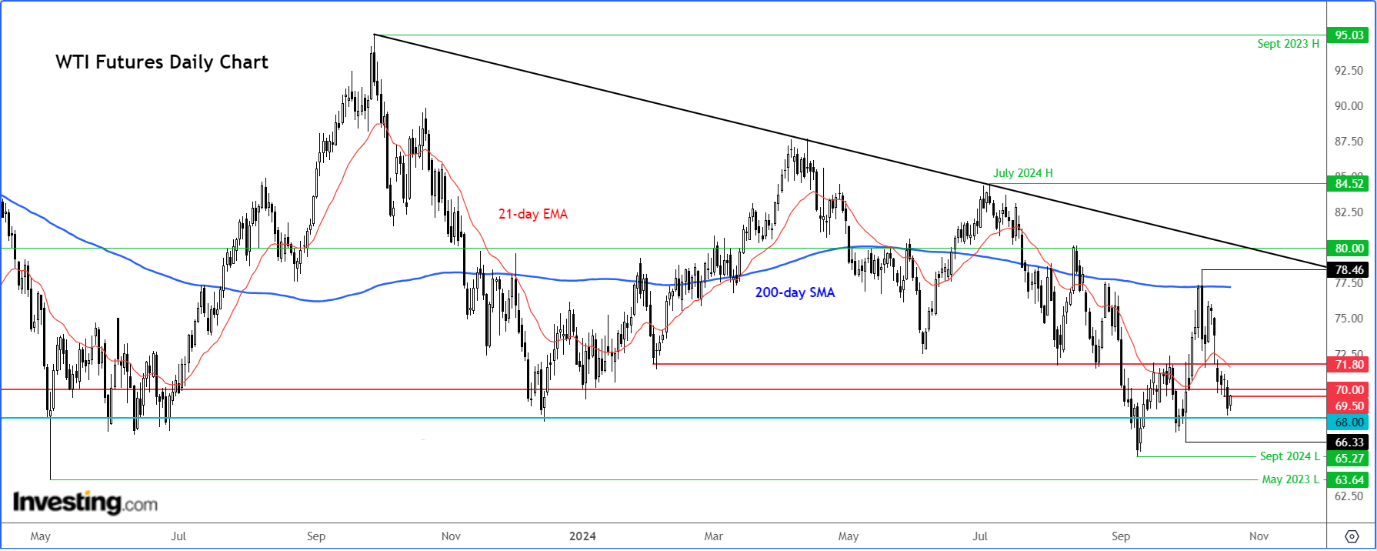- Crude oil prices rebound slightly but remain pressured.
- Middle East tensions stabilize as traders consider the potential impacts of the US presidential election on oil supply.
- A breach below $68 could push crude oil toward $65.
- Looking for actionable trade ideas to navigate the current market volatility? Unlock access to InvestingPro’s AI-selected stock winners for under $9 a month!
Crude oil prices rebounded more than 1% in the first half of Monday’s session. But after a 9% drop in the week before, the path of least resistance remains to the downside – especially while WTI remains below the long-term pivotal level of $70.00. Is oil heading towards $65 in the coming days?
Middle East tensions
A lot happened last week, and we could see some of the continuation of those moves in early parts of this week. Tensions in the Middle East remained somewhat stable, with Israel deciding not to strike Iran – at least for the time being – leading to a drop in oil prices. As anticipated, the ECB cut rates by 25 basis points, with Lagarde maintaining her dovish stance.
CPI figures came in lower than expected in the UK, Eurozone, and Canada, while US retail sales exceeded forecasts. Meanwhile, precious metals surged, with gold reaching new all-time highs and silver breaking through key resistance levels such as $32.50.
The metals have further extended those gains, but so far oil has not shown any further downside follow-through, perhaps because of the situation in Lebanon.
Oil traders are also paying attention to US presidential election
The market remains highly volatile and susceptible to sharp moves driven by headlines, making it essential to approach oil trading with extra caution.
Last week, WTI dropped nearly 9%, closing below the long-term pivotal level of $70.00. Traders may be also selling oil because of anticipation of a Trump victory in the US presidential election race. In his campaigning, Trump identified raising oil and gas output as a priority.
He has said that he wanted to be “a dictator for one day” to address two issues: “for drilling and for closing the border.” If Trump is elected, oil supply could increase further in the US, just as when the OPEC+ is expected to release some of its withheld supplies. This could only mean one thing: lower oil prices.
WTI technical analysis and trade ideas
Following last week’s reversal, crude oil remains rooted near its recent lows despite today’s decent bounce. Judging by the price action of the last few days, it looks like the bulls are finding it increasingly difficult to defend their ground around these levels, so a breakdown should not come as a major surprise, even while the Middle East tensions continue.

The bulls are feeling the heat after prices gave back most of their gains made earlier this month, with interim support levels at $71.80, $70.00, and $69.50 all giving way one after another. These levels are now the most important resistance levels to watch moving forward, with the area near $70.00 being an ideal spot for looking for trading opportunities. Any signs of a bearish reversal on the intraday charts here could be the trigger the bears would be looking for to send oil prices further lower.
In terms of support levels to watch, there are at least three levels that come into focus now. The first one is $68.00, which has not been broken decisively in the last couple of years. Even if we have had a few breaches of this $68.00 level, the downside has been fairly limited, before prices have invariably rebounded. But could that change this time around, with increasing signs of global weakness and increased supplies?
If the $68.00 support breaks, then stop resting below the most recent lows at $66.33, and $65.27 would be in trouble, meaning we could see a sharp downward move to take out liquidity resting there. Thus, a drop to $65.00 could be on the cards. This doesn’t necessarily mean oil prices will continue heading lower from there. Rather, it is where oil is most likely headed in the short-term outlook.
Indeed, the underlying trend is bearish. Not only do we have lower highs in place, but the bearish trend line established since prices peaked in September 2023, coupled with falling 21- and 200-day moving averages, tell you all you need to know about the direction of the trend in a non-subjective way.
***
Disclaimer: This article is written for informational purposes only; it does not constitute a solicitation, offer, advice, counsel or recommendation to invest as such it is not intended to incentivize the purchase of assets in any way. I would like to remind you that any type of asset, is evaluated from multiple perspectives and is highly risky and therefore, any investment decision and the associated risk remains with the investor.
